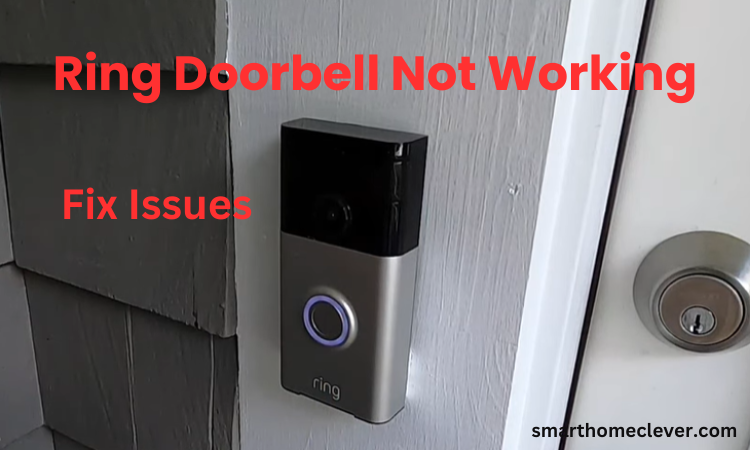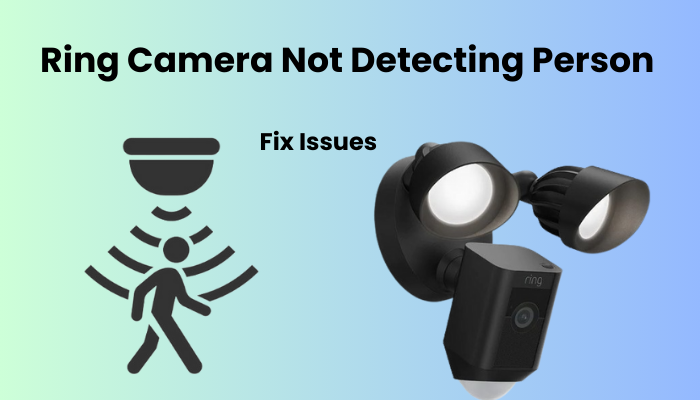Smart doorbells maintain home security and control remote monitoring of your surroundings even when you are away. A few months ago I bought a Ring Doorbell Not Detecting Motion because of its advanced motion detection AI and excellent performance in low-light conditions.
However, when my doorbell suddenly stopped detecting motion, my excitement grew. Which gave me no warning about the delivery on my porch, and reminded me of the time when my ring doorbell failed to ring.
This raised concerns that in particular, I set a speed warning sensitivity to a higher level in designated areas. It was an opportune cycle that ensured I had the option to determine without falling back on customer care.
After problem-solving, I found a minor error in my previous setting changes. To help others experiencing similar problems I have compiled a list of problems that can cause motion detection failure with their solutions for you.
If your problem persists you may need to contact customer care. A common culprit is the heat detection ring, a key component of the doorbell’s motion sensing. Low sensitivity settings of the doorbell may lead to its inability to detect any motion which you can troubleshoot.
Why is my Ring Doorbell camera not picking up motion?
If your Ring camera isn’t picking up motion, a few factors might be at play. Ensure it’s not a simple glitch by power cycling the camera, verifying it’s linked to a robust network, and confirming motion detection is activated in the settings.
Ring employs camera-based and infrared motion detection technologies utilizing PIR sensors, which detect heat signature changes within the camera’s field of view.
Several culprits could hinder motion detection:
- Misconfigured camera settings, covering sensitivity levels, activity zones, and modes.
- Weak network connection causing a failure to sync with cloud servers.
- Camera placement issues, like obstructions, glares, or window reflections.
- Power connection problems or low battery for wireless models.
- Software bugs or outdated firmware.
- Unfavorable weather conditions.
- Unclean camera and sensor lenses.
Be aware of potential false alarms, such as someone else accessing Live View or your mobile device obstructing notifications. Check your event recordings to rule out notification problems; if you have clips but no alerts, your phone may be blocking Ring’s notifications.
Fixing Ring Doorbell Not Detecting Motion
When your Ring device isn’t picking up motion, the first step is to check if the camera is online in the Ring app. You can do this by either loading a Live view or verifying the device’s connection in the settings.
Assuming the camera is connected, initiate a Live view to ensure you’re getting real-time footage. Before attempting this, power cycle both the camera and your network devices. Disconnect the camera, wait for a minute, and then reconnect it.
Allow the device to initiate and establish a connection with your network. Refresh the Ring app and access the device.
Open the Ring app, select the device on the home screen, tap Live View, and allow the camera to load. If the live view works, your camera is online, and the issue may be related to its motion detection settings.
If the Live view doesn’t load, your Ring camera might be offline, or the connection is weak. Verify the strength of the network signal using the Ring App:
- Select the device on the home screen or navigate through the menu to Devices > specific device.
- Tap the Settings Gear > Choose Device health > Check the Signal Strength RSSI value.
An ideal RSSI value ranges from 0 to -60 (green), while less than -60 (amber or red) signifies poor signal strength. Enhance the connection by moving the camera closer, using a Wi-Fi extender, or upgrading to a mesh network.
Now that we’ve confirmed your camera is online, let’s address the motion detection concerns.
Check The Camera Settings
- Camera Configuration: Ensure that your Ring camera is correctly configured by navigating to the device settings in the Ring app. Check for any recent updates and apply them if available. Sometimes, a basic software update can determine similarity issues and work on generally speaking execution.
- Power Source Verification: Confirm that your Ring camera is receiving adequate power. If it’s battery-powered, check the battery status, and if it’s hardwired, ensure a stable power supply. Insufficient power might cause the camera to function irregularly, impacting its ability to detect motion consistently.
- Infrared Settings: If your Ring camera has infrared (IR) capabilities for night vision, review the IR settings. Improper IR settings can prompt motion detection issues, particularly during low-light circumstances. Change the awareness and reach to advance the camera’s presentation in various lighting situations.
Check The Motion Detection Settings
Navigate to the Ring app’s motion detection settings and fine-tune the sensitivity. A high sensitivity could trigger false alarms, while a low setting might result in missed events. Experiment with the detection zones to focus on specific areas.
Additionally, ensure that the motion frequency setting aligns with your preferences. Regularly reviewing and adjusting these settings will help tailor your Ring camera’s motion detection to your specific environment, ensuring accurate alerts without unnecessary interruptions.
Ensure the Camera is Positioned Accurately
If the camera isn’t positioned correctly – whether there are obstacles in the way or it’s facing a window – you’re likely to run into issues with motion detection.
Make sure the camera is set up in a way that meets these basic requirements:
- Line of Sight: Ensure that the camera has a clear, unobstructed view of the area you want to monitor. Avoid placing it behind objects like trees, bushes, or fences that could block its view or trigger false motion alerts.
- Mounting Height: Install the camera at an appropriate height to capture the desired field of view. For outdoor cameras, it’s often recommended to mount them at a height of around 8 to 12 feet.
- Wi-Fi Signal: Take into account the strength of the Wi-Fi signal in the chosen location. A reliable Wi-Fi connection is crucial for the camera to function correctly and transmit video footage.
Wi-Fi Connection Issues
- Signal Strength Check: Assess the Wi-Fi signal strength in the location of your Ring camera. Weak signals can block communication and affect motion detection. Consider repositioning your router or investing in a Wi-Fi extender for further developed inclusion.
- Network Congestion: Identify and address any network congestion issues that might affect your Wi-Fi performance. Limit the number of connected devices or prioritize your Ring camera on the network to ensure a smooth and reliable connection.
- Router Reboot: A simple yet effective step is to reboot your router. This can determine impermanent errors and improve the general solidness of your Wi-Fi connection, possibly settling issues with motion detection on your Ring camera.
Addressing Heat Detection Problems
If you’ve tried adjusting app notifications and motion zone settings without resolving the issue, consider addressing the heat detection problem.
The Ring Doorbell relies on infrared or heat triggers to sense motion within the specified zone. You can modify sensitivity settings to alter the size of the heat signature detected by the doorbell.
This adjustment proves handy in filtering out alerts triggered by animals. To tweak the heat detection settings, follow these steps:
- Launch the Ring app and choose your Ring Doorbell.
- Navigate to Motion Settings.
- Choose the Zones and Range tab.
- Adjust the sensitivity of the sensors based on your preferences.
- This will determine the size of the heat signature the Ring Doorbell recognizes.
A lower sensitivity setting means fewer alerts, and the doorbell will only detect heat signatures near the sensor.
Adjust the sensitivity settings for Motion Detection
The manufacturer recommends setting the motion detection sensitivity to the “standard” level for optimal performance. This setting is believed to be ideal for effectively detecting motion. Keep in mind that if the motion detection is turned off, your Ring Doorbell may not go live.
If the default setting doesn’t suit your needs, you have the flexibility to explore and adjust various options. Experiment with each setting individually and stick to the one that yields the desired results.
To customize the sensitivity of your Ring Doorbell Not Detecting Motion, follow these steps:
- Open the Ring App and choose your Ring Doorbell from the list of connected devices.
- Navigate to Motion Settings.
- Select Zones and Ranges to specify the alert zone and detection range.
- Use the top slider to fine-tune the sensitivity.
- Confirm and save the new settings by pressing the Ring Doorbell button as prompted in the pop-up.
- Tap Continue.
- Go to Smart Alert and choose the preferred alert frequency.
- Save your selections.
If you’re inundated with motion alerts, consider slightly lowering the sensitivity.
Firmware and Software Updates
If your Ring camera is acting up, a common culprit could be outdated firmware or an outdated Ring App. They regularly roll out updates to fix bugs and enhance performance.
Before you hit that update button, it’s worth checking your app’s cache level. A bloated cache can slow down the app and mess with its functionality. Clear the cache and shut down the app for a fresh start.
Head to your app store to make sure you’re using the latest version of the app.
For an extra kick, sign out and then back into your account. This can give your app the refresh it needs.
Once your app is all spiffed up, take a peek at your Ring camera’s firmware. Updates often tackle performance issues or introduce cool new features.
Typically, your Ring camera should update itself during events, but if it misses one, you can manually check it in the Ring app.
Here’s how:
- Open the Ring app and select the camera from your home screen.
- Tap on the Device Health button.
- Look for Firmware under the device details.
- If it says “Up to date,” you’re good to go. If there’s a number, you’ve got an update waiting.
Update the camera firmware, and let’s see if that live stream starts playing nice again.
Factory Reset The Camera and Reconnect
When you perform a factory reset on the camera, it brings back all the original settings and erases any adjustments you’ve made. After this, you’ll need to reconnect the camera to your home network.
Resetting is valuable for disposing of any wrecked design records that may be influencing how well the camera works. Once you’ve reconnected the camera, it automatically updates to the newest firmware.
Just a heads up, make sure to save any important clips before hitting the reset button on your device.
To factory reset:
- Locate the reset button on your camera.
- Tap and hold the reset button for about 25 to 30 seconds.
- Let the camera finish resetting and enter setup mode.
- Now, go ahead and reconnect the camera to the Ring app. This should bring back all the default functions. You can then personalize the camera settings to your liking.
Contact Support
If all else fails, don’t hesitate to contact Ring’s dedicated support team. Before connecting, assemble essential gadget data, including the camera model and firmware rendition. Explore Ring’s internet-based assets for likely handy solutions. If the issue continues to happen, present a help demand through the application or site, specifying your troubleshooting steps.
The support team will provide personalized assistance, guiding you through diagnostics and offering solutions to address the motion detection challenges with your Ring camera.
Frequently Asked Questions:
Q: Why is my Ring motion sensor not working?
A: Several factors could contribute to a non-functional motion sensor. Begin by examining the device settings within the Ring app. Ensure the motion detection feature is enabled, and adjust sensitivity settings if necessary. Additionally, confirm that the camera lens is clean and unobstructed, as dirt or debris can interfere with accurate motion detection.
Q: Why is my Ring Doorbell not notifying motion?
A: If your Ring Doorbell isn’t sending motion notifications, verify that your notification settings are correctly configured in the Ring app. Check your smartphone’s notification settings to ensure they allow Ring notifications. Additionally, review the Wi-Fi connection to guarantee a stable network, as a poor connection might result in delayed or missed notifications.
Q: Why is my Ring Doorbell going off with no motion?
A: Unexpected alerts without visible motion may indicate sensitivity issues. Adjust the motion sensitivity settings in the Ring app to find the optimal level for your environment. Also, inspect the detection zones to exclude areas with unnecessary movement. If the problem persists, consider updating the app and firmware, as software glitches could trigger false alerts.



